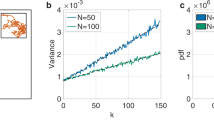Abstract
Our theory of collective motions of open system [2,3] is generalized to the case of systems distributed inm-dimensional space. We propose a rigorous definition of a particle in terms of systems theory. A concrete image of a particle, conceived as a localized collective entity in Space, is obtained. It turns out that wave-corpuscle duality is nothing else but a simple consequence of general equations of collective motions: particles appear at the output as collective manifestations of inner states, and waves appear at the input as guiding waves of particles.
Similar content being viewed by others
References
Louis de Broglie, Introduction a la Nouvelle Theory des Particles. Gauther-Villar, Paris 1961.
M.S. Livŝic, in Commuting Nonselfadjoint Operators in Hilbert Space, Lecture Notes in Math. 1272, Springer-verlag, 1987, pp. 1–39.
M.S. Livŝic and Y. Avishai, A Study of Solitonic Combinations Based on the Theory of Commuting Non-Self-Adjoint Operators, Linear Algebra and its Applications 122/123/124: 357–414 (1989).
Author information
Authors and Affiliations
Additional information
The David and Helena Zlotowski chair in Operator Theory and Systems Theory.
Rights and permissions
About this article
Cite this article
Livŝic, M.S. What is a particle from the standpoint of systems theory?. Integr equ oper theory 14, 552–563 (1991). https://doi.org/10.1007/BF01204265
Received:
Issue Date:
DOI: https://doi.org/10.1007/BF01204265




